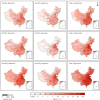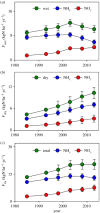Environmental impacts of nitrogen emissions in China and the role of policies in emission reduction
- PMID: 32981443
- PMCID: PMC7536030
- DOI: 10.1098/rsta.2019.0324
Environmental impacts of nitrogen emissions in China and the role of policies in emission reduction
Abstract
Atmospheric reactive nitrogen (Nr) has been a cause of serious environmental pollution in China. Historically, China used too little Nr in its agriculture to feed its population. However, with the rapid increase in N fertilizer use for food production and fossil fuel consumption for energy supply over the last four decades, increasing gaseous Nr species (e.g. NH3 and NOx) have been emitted to the atmosphere and then deposited as wet and dry deposition, with adverse impacts on air, water and soil quality as well as plant biodiversity and human health. This paper reviews the issues associated with this in a holistic way. The emissions, deposition, impacts, actions and regulations for the mitigation of atmospheric Nr are discussed systematically. Both NH3 and NOx make major contributions to environmental pollution but especially to the formation of secondary fine particulate matter (PM2.5), which impacts human health and light scattering (haze). In addition, atmospheric deposition of NH3 and NOx causes adverse impacts on terrestrial and aquatic ecosystems due to acidification and eutrophication. Regulations and practices introduced by China that meet the urgent need to reduce Nr emissions are explained and resulting effects on emissions are discussed. Recommendations for improving future N management for achieving 'win-win' outcomes for Chinese agricultural production and food supply, and human and environmental health, are described. This article is part of a discussion meeting issue 'Air quality, past present and future'.
Keywords: China; ammonia; eutrophication; integrated nitrogen management; nitrogen oxides; particulate pollution.
Conflict of interest statement
We declare we have no competing interests.
Figures






References
-
- Erisman JW, Sutton MA, Galloway J, Klimont Z, Winiwarter W. 2008. How a century of ammonia synthesis changed the world. Nat. Geosci. 1, 636–639. (10.1038/ngeo325) - DOI
-
- Kanter DR, Searchinger TD. 2018. A technology-forcing approach to reduce nitrogen pollution. Nat. Sustain. 1, 544–552. (10.1038/s41893-018-0143-8) - DOI
-
- Liu XJ, et al. In revision Balancing nitrogen inputs to reconcile China's food supply and environmental safety. Nat. Commun.
Publication types
MeSH terms
Substances
LinkOut - more resources
Full Text Sources
Medical
Miscellaneous
